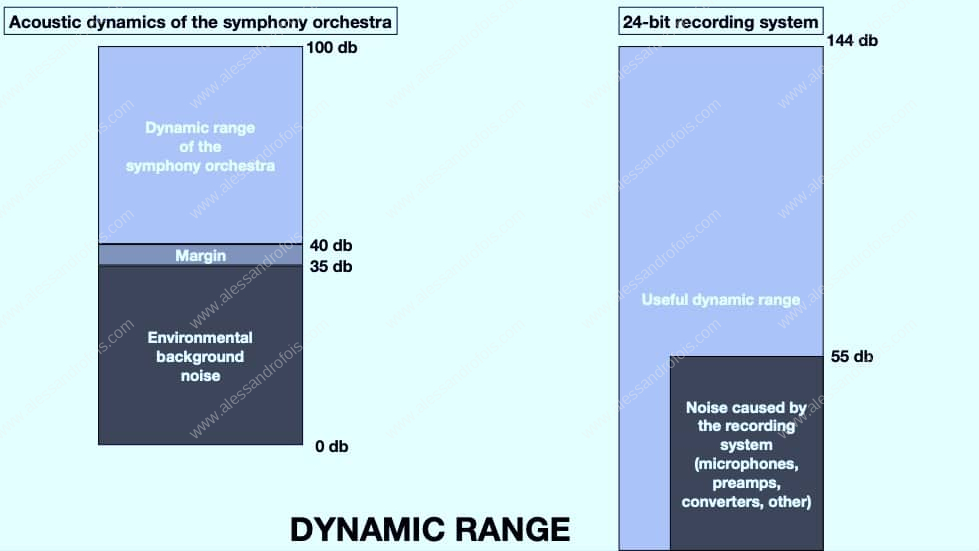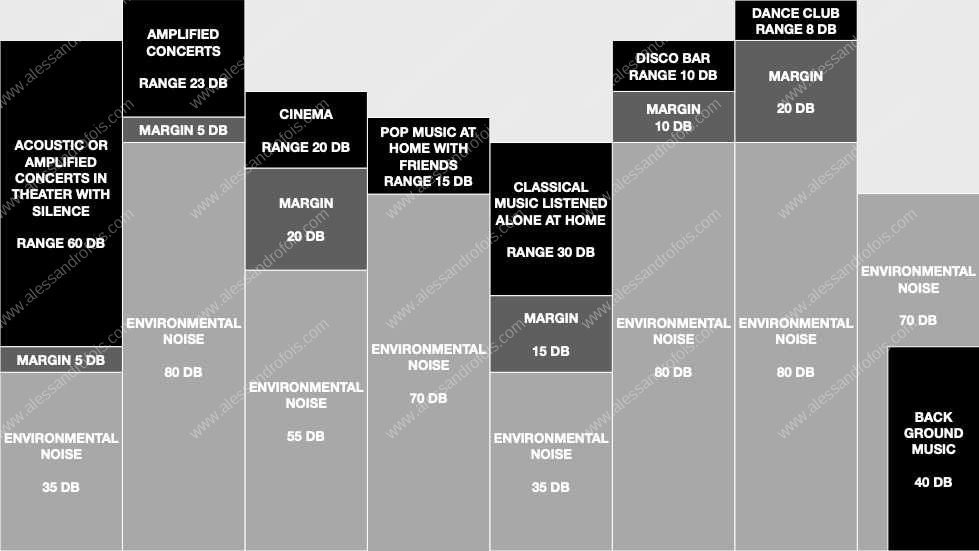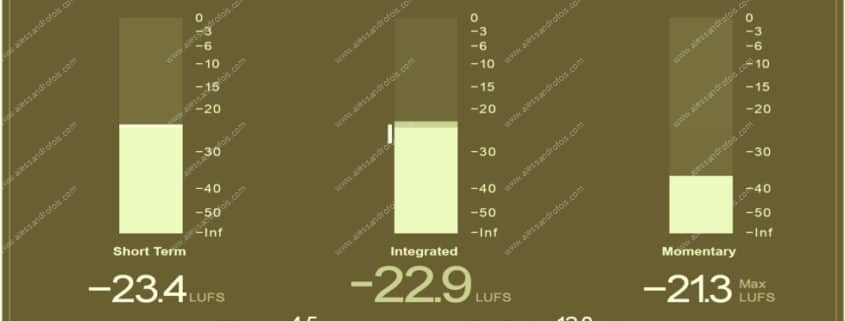Loudness in mastering - part 1
- Author Profile
- Recent posts
Pianist, Composer, Arranger, Sound Engineer, Writer, Blogger
Alessandro Fois is a musician, composer, pianist, arranger and sound engineer. Since 2018, he has also been a writer, blogger and webmaster. He currently resides in Ivrea (Turin) where, in addition to the above activities, he manages Lycnos, studio for audio, video and web services, and the recording studio Glamour Recording Studio.
Dynamics
Dynamic amplitude
In a piece of music or in speech, it is the difference in volume between phrasing at a lower volume and phrasing at a higher volume.
In the field of acoustic music (without amplification), that performed by the great 'romantic' symphony orchestra is the one with the greatest dynamic range, which can reach a dynamic range of 60 db.
With such music, the listening volume in auditoriums can reach peak sound levels of around 100 db (the most intense full-orchestra accents also referred to as 'hits').
It will be possible to distinguish even the most delicate musical passages, which could reach a minimum threshold of around 40 db provided the ambient background noise level is sufficiently below this level (there is sufficient silence in the theatre).
In order to ensure that even a large part of the harmonic content is not lost in very low volume passages, it will therefore be necessary to maintain as high a 'margin' distance as possible between the level of such passages and the background noise threshold.
An example:
- 35 db of ambient background noise present in an average crowded concert hall
- + 5db margin
- + 60db at the most intense points of music
- = 100 db maximum listening volume in 'loud' peaks
In practice, however, we have the need to be able to listen to recorded music at much more moderate listening volumes, which allow for good enjoyment even in situations where it would not be possible to overpower the background noise by 60 db, such as listening at relaxing volumes, at night, in noisy places, in a car with the engine running, in small speakers, as background music.
Under such conditions, listening will be more enjoyable if the natural dynamic range of the music or speech is significantly reduced (e.g. to half or even much more) in order to make the most delicate musical passages sufficiently audible even under such circumstances.
Therefore, take into account that: the lower the listening volume, the higher the background noise, and consequently the smaller the dynamic range should be, in order to guarantee the enjoyment of each musical passage without losing something on the way during listening.
Conversely, the reduction of dynamic range will tend to flatten dynamic expressiveness more and more, with 'pianissimo' being strengthened and fortissimo accents mortified, resulting in a usable but boring listening experience.
Measured mean dynamic intensity
La average dynamic intensityexpressed in RMSis the average level of the sum of the peak values detected on the timeline of a piece (or fragment thereof).
Perceived average dynamic intensity
Expressed in LUFS, L'perceived average dynamic intensity also called simply Loudness or even better Integrated Loudnessbroadly corresponds to the measured average dynamic intensity above, but also introduces new elements of calculation, including:
- a measurement based on human perceptual, rather than solely electroacoustic, criteria, which differ in relation to frequency and speed of dynamic contrast
- an appropriate decrease in sensitivity during performance pauses and in low-intensity musical passages below a certain threshold
As we shall see, theperceived average dynamic intensity is the latest and most useful criterion for assessing the loudness of a song, which is particularly useful in the field of mastering.

On the left is the acoustic dynamic space of the orchestra, which can fully express itself provided the ambient noise is 35 dB or less. On the right is a comparison with the useful dynamics of a 24-bit digital recording system, equal to 144 dB, whose 'weak links' in the area of dynamics are the analogue components and converters. By using very high-profile equipment and paying attention to the use of levels, it is still possible to guarantee useful dynamics equal to that of the large symphony orchestra (60 dB maximum) even when recording with maximum peaks at very low levels (down to -30 dB). Consequently the widespread practice of recording with peaks at -12 dB (or even -18 dB) will fully respect the 'extreme' dynamics of this orchestral ensemble.
Listening
Before going any further, let us give some analytical examples of the most typical listening situations in our day:
- acoustic or amplified concerts, in theatre, with controlled acoustics and silence in the auditorium - dynamic range up to 60 db (power output 40 to 100 db)
- amplified concerts with noisy auditorium - dynamic range of approx. 25 db (power output 85 to 110 db)
- audiovisual projections - dynamic range of about 20 db (variable emission power depending on the place of use - examples: 35 to 60 db in very quiet auditoriums, such as in a museum - 75 to 95 db in medium quiet auditoriums where a certain sound impact is required, such as a cinema - 90 to 110 db in noisy auditoriums, such as during the public screening of a football match at a street party
- pop music listened to at home with friends - 15 db dynamic range - (power output 75 to 90 db)
- non-symphonic classical music listened to at home alone - 30 db dynamic range - (power output 50 to 80 db)
- music in a disco bar (sustained listening volume) - dynamic range 10 db - (power output 90 to 100 db)
- music for dancing in a modern disco - dynamic range 10 db - (power output 100 to 110 db, very tiring to the ear
- music in the background - no useful dynamic range, except in passing - as the readability of the music will be mostly disturbed by ambient noise of varying intensity

Comparative representation of listening and ambient noise levels; the latter should be overpowered in order to guarantee sufficiently wide dynamics for full enjoyment of the sound content. Note that at least a 5 db margin is advisable for greater sharpness of the more 'delicate' sound passages. Note, on the other hand, the forcing of volume in discotheques and disco bars, with margins that are too wide for sound content with very compressed dynamics: an unnecessary load on the eardrums at very high volume. Finally, consider the substantial "non-usability" of the sound in background music, whose expressive range will often be completely incorporated in the ambient background noise.
As can be seen, in order to guarantee the enjoyment of the entire musical fabric, the dynamics will have to be all the more compressed the higher the ambient noise level.
For background music, a clear, continuous and correct readability of the musical content will not be possible (except in short bursts).
N.B.
There are also cases (music in discotheques, for example) in which we insist on keeping, by established custom, highly compressed music at a very high level, creating very wide margins (even 15-20 dB) with respect to the background noise threshold determined by the audience (noisy as it may be), which would allow us to lower the level by at least 10-15 dB, with great relief for the health of the ears.
Natural dynamics
We said that a musical performance is expressed within a dynamic-expressive range extending from a minimum sound emission level to the maximum peak produced during 'loudest' moments.
The difference in volume expressed in decibels (db) between the above-mentioned two extremes is referred to as the 'dynamic amplitude' of the song or also simply 'dynamics'.
When recording audio, the performance imprints a 'trace' (magnetic or numeric) on a medium.
As a practical matter, in the search for optimisation as well as a standard, one always tries to match the highest peak of an execution with the point of maximum undistorted dynamic containment granted by the medium itself (in our case the audio file), avoiding exceeding this limit in order to avoid the distortion of the original sound wave (it is just like filling a bucket to the brim, without dropping a single drop).
In digital systems, the 'limit' is considered to be the clipping point corresponding to a level of 0 db on the digital scale (which corresponds to the switching on of the last red LED at the top.
This limit must not be exceeded, and it would be better if it were not even reached, reserving an appropriate margin of tolerance, which should be between 0.2 db and 2 db, as the case may be; it is generally set at 1 db in streaming, while it is more often set at 0.3 db in mastering for CD production
As we shall see, an accurate measurement of True Peak will allow the most appropriate tolerance margin to be chosen.
As we have considered, some acoustic performances use a dynamic space even higher than 60 db, which can be considered about 90 db including moments of absolute silence, which are also part of the track's expressive range (practically speaking, this involves using the full dynamic range offered by a top-quality professional analogue recorder, or a 16-bit digital system, which is the main standard for finalisation commercial music audio files).
The above can be detected, for example, in some pieces performed by the large symphony orchestra: from the flute solo in pianissimo register to the fortissimo accents of the entire orchestra, passing through pauses and performance contractions of almost absolute silence.
In order to ensure a listening experience capable of capturing the full dynamic range, a volume level should be used that, at maximum peaks, exceeds the ambient background noise by at least 60 db, in order to be able to perceive the pianissimo points at least slightly above the ambient noise level.
Obviously, this will only be possible in very quiet environments, such as in a theatre during a concert, where the background noise does not exceed 35 db, allowing good audibility even during passages from pianissimo (with an acoustic pressure of 40 db) to fortissimo (100 db)
A concert with such a wide dynamic range, therefore, will not be fully appreciable in environments with high ambient noise (such as at a 'beer festival'); in such environments, in order to perceive the full dynamic range, it would be necessary to push the fortissimo register far above the threshold of rupture of the ear drums.
Dynamics in recording
Hence the practical need, in most listening circumstances, both in amplified live performances and in the reproduction of recorded music, to reduce dynamic amplitude of sound reproductions to appropriate values that allow for a sufficiently correct enjoyment of music in the various listening circumstances.
With a sufficiently 'pushed' compression level, it will be possible to hear music in detail even at levels slightly above the ambient noise level, which is useful for:
- avoid disturbing neighbours
- do not fatigue or damage your ears with loud peaks when listening in noisy environments
As will be obvious, certain genres of music, as a matter of 'sound culture', will be strongly penalised by heavy compression (e.g. classical music and other genres that can be defined as 'purist'; others, on the other hand, may even be advantaged to a certain extent (e.g. rock-pop-dance genres).
N.B.
Exaggerated compression, on the other hand, is not beneficial even for more 'hard' music genres (such as dance music) as it will tend to
- transforming the useful audio signal into something resembling white noise, to a greater or lesser extent, depending on the extent of compression applied, which is a phenomenon that is more noticeable at high frequencies (which tend to become 'iron';
- insert increasingly audible frequency intermodulations into the sound that interfere with the natural harmonics of the sound, creating additional harmonic beats, which dirty the sound and diminish the perception of the harmonic-musical mixture.
To prevent the background noise and other disorders inherent in recording media (e.g. the swoosh of analogue tapes) was sought:
- to keep the maximum peak of the recording at as high a level as possible, but below the point of distortion
- by compress I "dynamic useful space" in a relatively narrow range, capable of reproducing a functional dynamic range for various types of use but wide enough to decently reproduce the dynamic expressiveness of music
In the following years, particularly in the area of pop, the production industry gradually reduced the dynamic space, compressing it more and more in order to increase the volume of the lowest moments of the performance dynamics, until the dynamic space used was reduced to a few db.
As we shall see, the phenomenon has seriously accelerated with the advent of digital media.
Over the course of some 20 years (from the 1990s to the 10s of the third millennium), the need to compress music to ensure its more convenient enjoyment gradually turned into an unbridled race to Perceivable volume.
The aim, encouraged by the producers, was to 'loudness' the sound impact of competing music productions, which triggered a real Volume Wardefined as 'Loudness War'.
Follows in Part 2: https://www.alessandrofois.com/loudness-nel-mastering-parte-2/






Leave a Reply
Want to join the discussion?Feel free to contribute!